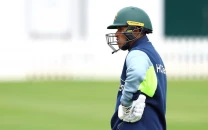Cornered tigresses
Women’s sports victories will only feed our patriotic egos for a day until we learn how to really support them.

Champions allow us to believe in ourselves, harnessing the cultural cynicism that finds root when some icons move on unexpectedly to occupy villainous spaces. Pakistan’s political and sports history is replete with such disillusionments. We tend to adopt heroes recklessly and then turn bolshie when they fall from grace. No disenchantment has been more complete than that with men’s national cricket. Finally, a demoralised, perplexed nation has had to turn to other teams and games for succour. This year our “cornered tigers,” to borrow freely from skipper Imran Khan’s famous speech at the 1992 World Cup, have morphed into unleashed tigresses. The Pakistan women’s cricket team brought home the gold from Guangzhou and captured the patriotic imagination. Earlier, Naseem Hameed raced to glory at the South Asian games. Equally, Maria Toor’s journey from gender disguise in Waziristan to Pakistan’s number one squash player garnered international press. These stories shared a common thread; each featured charismatic individuals fighting tooth and nail to win. Who doesn’t love an underdog? What has this public attention done for women’s sports in Pakistan? To some extent, it has jolted it into national focus. Bushra Aitzaz, head of the Pakistan Cricket Board‘s women’s wing, argues that it has “made people aware that women’s cricket exists. Now that they’ve bought honour to the country, no one can say they shouldn’t play.” Nothing succeeds like success.
Women’s participation in sport has always been a contentious issue in Pakistan. Despite family opposition and embarrassingly low stipends, the Pakistan’s women’s team has batted valiantly on a tough wicket. “The Asiad gold may finally get the girls a proper ground and a training academy,” surmises Aitzaz who has been exasperated by the fact that the Gaddafi stadium "is always booked for men.”
However, the momentary euphoria from the win has yet to be transformed into concrete benefits or even sustained media interest. Sports journalist Shazia Hasan refers to the negligible coverage of the recent under-19 women’s tournament in Lahore as a case in point. The real issue, as Hasan sees it, is that women’s sport is “protected” from mass viewership through archaic rules and “a tacit agreement from the players themselves.” Currently, men can only watch women’s cricket in a stadium as part of a family. With such restrictions, the audience for women’s sports in Pakistan remains stunted. On another level, we tend to forget that heroes need us as much as we need them. When sportswomen return victorious they are rewarded with cash prizes from a government happy to bask in reflected glory. However, little is done to actually galvanise the sport in the long run. Ten months after Dhaka, Naseem Hameed and Karate gold medalist Sara Nasir are yet to operate as sports ambassadors despite being appointed by President Zardari. “The government makes announcements and then has memory loss,” complains a crestfallen Hameed. She emphasises the need for a grass-roots engagement of young girls interested in playing sports. “People congratulate me but continue stopping their daughters [from entering sports]. How can I be a role model when I’m just an ambassador in name?”
As the sweet smell of success fades, the sports infrastructure continues to stink. The media moves on to another hero. Coaches do the best they can with outmoded equipment and techniques. And the resources and funding promised in the flush of victory fail to materialise.
Until we transform these fleeting moments of triumph into recognition and infrastructural support, women’s sports victories will only feed our patriotic egos for a day. We owe a little more to our cornered tigresses if we really want them to live to fight another day.
Published in The Express Tribune, December 6th, 2010.



















COMMENTS
Comments are moderated and generally will be posted if they are on-topic and not abusive.
For more information, please see our Comments FAQ